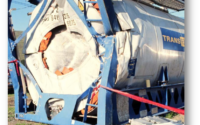Sammy Slime on the Salty Soapbox presents: Vitals illusion confusion – Part 1
Armando S. Bevelacqua
Let me set the stage. Most of you know me, as a hazmat guy, and specifically medical hazmat guy. Yes, it’s true that most of my career has been in the hazmat and paramedical field. But there was a time where I was involved with technical rescue, dive rescue, and even a flight medic. However, basically 90% of my career has been in some form or shape of special operations. Yes, fire was fun, EMS was challenging, but special operations was an area that really spoke to me, and more specifically hazardous materials response.
The one thing that transcends all of emergency work is the fact of safety. Special operations will take a motivated educated individual but more importantly someone that is safety minded and trains them in specific skills. Hazardous materials response is part of this segment population of responders. They are always looking for the safety aspects of an emergency incident. I don’t have a problem with safety on an emergency scene, God knows how many firefighters we lose and injury every year. Could some of these events be curtailed? Who knows, but there are a few things to get my crawl and the reason for this article this month (and maybe next month).
One of these issues that gets my craw……… standby let me get Sammy up on his salty soapbox……… Is the idea, or the desire is probably a better word, for an easy button. A formula, if you will, to readily justify the physiology of an individual prior to entry into a hazardous materials incident. That is the nice way of saying that a formula to one’s health is on a piece of paper which we will fill out at the scene of an event and will somehow justify the medical “I did it” box. I am speaking directly to pre-entry physicals! I have even heard that this philosophy or idea has even transcended into other special operational disciplines such as confined space and trench rescue. Well, let me set the record straight I believe in the concept of pre-entry physicals, I just don’t think they are being applied properly. Why you ask, because from what I have seen and read about is that it is the responders that are not being educated properly. That’s possibly one explanation, or maybe there is such a heightened awareness of safety that we’re forgetting that this is an emergency service and you may have to forgo a procedure to save a life. I’m not sure where it’s coming from but I’d like to address this issue head on and investigate it on several levels.
Let’s start out by using our time machine and go back to the historical documents we called NFPA 471. Ok so back in the old days (for you young guys and gals 1985–1989-time frame and lasted until 2008) there was a document that outlined the basic concepts and procedures of a hazmat response. It wasn’t a bad document; looking back on 471 it was actually fairly good. The reason for this document was to give a framework of what a HazMat response should look like. At the time very few books and classes out there to identify what is needed, how it is done and what to consider. It outlined hazmat definitions (wow this is a whole area of concern – Sammy will have to address this one in another article), and incident response planning, site safety, PPE, Mitigation, decon, and medical monitoring, this document was NFPA 471. It was retired in 2008 because the hazmat committee at the time felt that there was very little need to continue with general basic practice. A few years later the committee asked if 471 can be brought back, but instead NFPA 475 was developed to highlight the changed environment that had occurred in the special operations arena.

Back to 1985; as a part of the document, chapter 10 to be exact, looked at the medical monitoring with the discussions centering around the medical issues at the hazmat event. We have to remember that the medical science of the day, or rather the best practice, was considered as a recommended practice to be employed easily and established in the field prior to entry. But let’s restate that sentence again, it was the opinion of the medical community back then, the current medical guidelines that could be used as a bases of field medical evaluations. During the 80’s and into the 90’s establishing range numbers for blood
pressure, pulse and respiratory status was different then the numbers that we use today, especially blood pressure. The guidelines that were used in the 1980s would give us pause today as the numbers have lowered. What was once good “normal” numbers have changed and would be considered out of range, or an unhealthy individual today.
The idea back then was to give guidance to the medical crew at the scene of the hazardous materials incident. Remember that the education in those day was extremely limited so to have knowledgeable responders towards hazmat was sparce. It was basically a quick medical looksee which could give an indication of whether that individual should go into the hazardous environment or not. Oh boy does this have holes worse than Swiss cheese! Let me address each issue. But I am going to start this criticism with a project I was involved with a few years back.
Don Abbott the founder of Project Mayday and retired chief officer had been looking at fire maydays trying to see the common thread within these incidents. He spread his wings to encompass HazMat Maydays as well. He had many incidents that were well documented from incidents reports to radio transmissions, scene documentation as well as interviews of the crews on scene which he performed himself. The amount of information was not lacking it was daunting. Myself and another HazMat Medic looked at the plethora of information and identified a few issues with the pre-entry physical documentation. What we saw was that the medical responders were either not educated, didn’t care, or knew but couldn’t do anything about it. Not sure which one it is, but what was observed and what was documented as vitals should have indicated to that medical responder that the person they evaluated should have never been allowed into the environment. And this was not just one incident there where many. Now for those of you that are looking at this statement and reading this article and are hard core pre-entry physical enthusiasts, and take this as, you see there; pre-entry physicals should be done; need to be done; have to be done!!! Hold your horses for a second Tiger (an extremely derogatory term I learned from my engineer many years ago). Let’s review, nothing was done to intercede the problem, was the problem actually identified, understood or ignored? These reports were very telling in that these pre-entry physicals are done as a bench mark of the event and not what they are intended for, and that is of health and safety of the responders. It would have been better if they never did anything, rather they documented case after case of individuals that should have not be allowed in a Level A suit!
They went through the process of taking vitals; of documenting the vitals, and even in some cases, responding to the safety officer, telling the safety officer that these entry team members were good to go. In several cases, I believe the responder, the paramedic or EMT whoever was performing the pre-entry physicals, didn’t understand some of the numbers. In these cases, they were borderline heat stress, even before they went into their Level A suit, and you guessed it what was the mayday… heat stress!! Some of you are sitting back and saying see you just made my argument for me, please continue! Hold on!!
They were involved in the process, acted but no follow through. Which is worse? I am not saying that pre-entry physicals should not be a part of your entry procedure all I am saying is that we need to be better at looking at this complex problem, understand it and manage it. We are not in my opinion managing it properly. Back when HazMat became a response, wgen we didn’t know much about the levels of complexity taking a blood pressure, evaluating pulse and respirations along with mentation seemed rational. However, this is back when pulse oximetry was in the operating rooms and capnography was years in the future.
Now we are better equipped and hopefully better educated. We have both the ability to look at SaO2 and EtCO2 along with weight would give us much better indication as baseline then the BP, P, R or even EKG. Remember we are not talking about an injured person, of an individual that has a disease process progressing. We are talking about men and women that have taken an annual (or biannual) physical and are considered medically fit. We have to because of our jobs pass the medical along with a respiratory lung evaluation in order to wear and use our respirators. Now that is OSHA. Let’s see what OSHA has to say about this issue next month. Because that drives our response and the pre-entry physical is in OSHA! Right?




